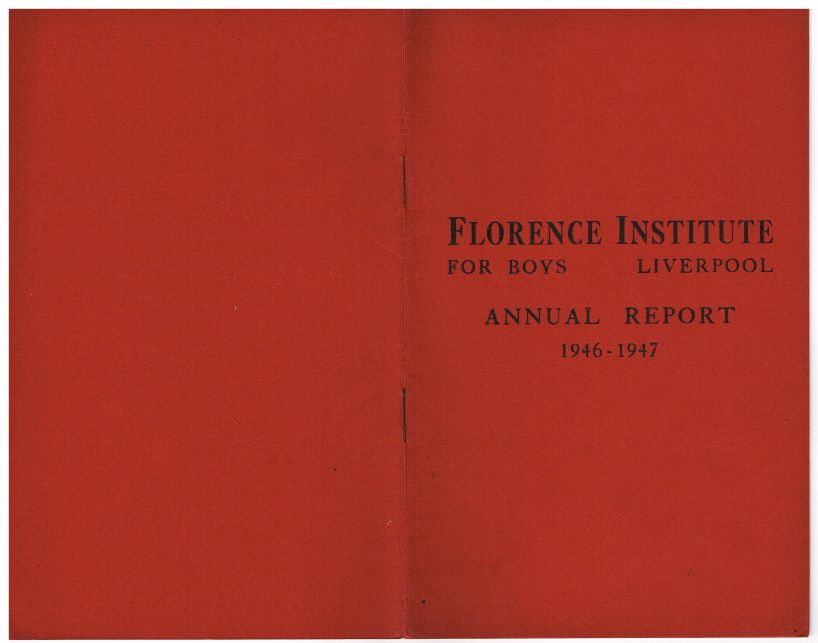
1946
In this report, the Committee were keen to clearly outline the Institute’s influential community role post WW2:
The Florence Institute was affiliated with The Liverpool Federation for Boys Club, who in turn were affiliated with The National Association of Boys Clubs in London. Commonly, Youth Organisations played their part in the furtherance of the government’s scheme for the ‘Service of Youth’. In conjunction with the schools, the Institute was ‘trying to equip each member with a sound educational background with which he may approach the future.’ At the tender age of just 15, it was normal for boys to leave school and start work, ultimately making them adults to fend for themselves in the world. This was a world where large numbers of adults struggled to make ends meet, with food and clothing in short supply, at a time when material values counted for so much.
A role of the Boys Club Movement was to give the boys a ‘sane and balanced outlook towards life and in helping him, at a critical time in his life, to assess the real value of some of the things which he sees and hears going on around him.’ There was a degree of discipline within the club, often self-imposed, that gave a steadying influence to the boys, affording them the confidence and ability to take their rightful place amongst their community. The club helped to supplement family life by means of promoting free exchanges of thought between helpers and the boys, giving them the opportunity for self-improvement via the help of others.
The Liverpool Education Committee recognised the lack of attention being afforded to boys aged 11-14, which inspired the Institute to launch ‘The Florrie Pioneers’. Fundamentally a school-boys club, the Pioneers was open between the hours of 5pm-7pm, with 70+ attendees taking part in activities such as woodwork, basketball, gymnastics, boxing and football. This was even extended to a week’s camping in Heswall.
At the opposite end of the scale, the ‘Old Boys Club’ was firmly established this year. The Club was given its own space in the building’s basement, under the guidance of its secretary, Mr Galvin, himself a Florence Old Boy. Extended thanks were afforded to Mr. J.R. Gibbons, Chairman of The Florence Oxton Men’s Club, for his hard work and promise to aid the Club financially. Words of appreciation were also given to Mrs. Leslie Hanmer for her fundraising efforts for The Ladies Committee.
Financially, the accounts disclosed a gap, so adverse ‘elsewhere it would cause Governments to falter and Oppositions to clamour for a general election’. Despite this, the Institute’s mandate to cater for the needs of the youth and neighbourhood remained.
The Florencian
March 1946
This newsletter began with a post-war message from the Honorary Treasurer: ‘First things first, and one is that we should be very thankful that our building came to no serious harm during the blitzes on our City (our tower had to be removed as being dangerous, no doubt the result of enemy action). Had the Florrie become a casualty, I feel sure the boys of the neighbourhood would have realised what the Club meant to them, and its loss would have made a gap in their lives at a very important age.’
It reflected on the great camaraderie at the Institute- and a sense of togetherness and familiarity enjoyed by members, both in their ‘houses’ and as part of the Institute as a whole. It reported that the Florrie’s Houses were named Aigburth, Sefton, Toxteth and Stanley.
This addition included , for the first time in our archive, a quiz page, under the heading of ‘Florenciana’, which could be filled in with details from the newsletter. There was also a crossword puzzle.
A report on Thurstaston Camp offered a reflection on the initiation ceremonies of new campers, and characters: ‘This involved throwing them into the ‘Ratty’. This is an old tradition of the ‘Florrie’ week-end camps. Personally I do not think it is much a tradition as a feeling of revenge. Unfortunately the ‘initiators’ cannot revenge themselves on the Old Boys who christened them so they take it out of the poor and innocent juniors. The seniors also amuse themselves by tossing each other up in a blanket. One senior, Billy Black did not enjoy the experience as he was tossed up and then the other seniors walked away before he had come down. Mr. Jones, however, put a stop to this as it was ruining the blankets. Joe Smith ‘the Mad Barber of Mill Street’ took some photographs the results of which remain to be seen. Joe seems to have a hand in most things. One day he is an accomplished squeeze box player, another he is an expert barber then a photographer and above all he is a real lady killer at all times.’
THE FLORENCE INSTITUTE
- 0151 728 2323
- info@theflorrie.org
- 377 Mill Street, L8 4RF
- We are open: 9am – 6pm Monday to Friday.
Registered Office: The Florence Institute Trust Ltd, 377 Mill Street, Liverpool L8 4RF. Charity Registration No: 1109301. Company Registration No: 05330850 (registered in England and Wales).
